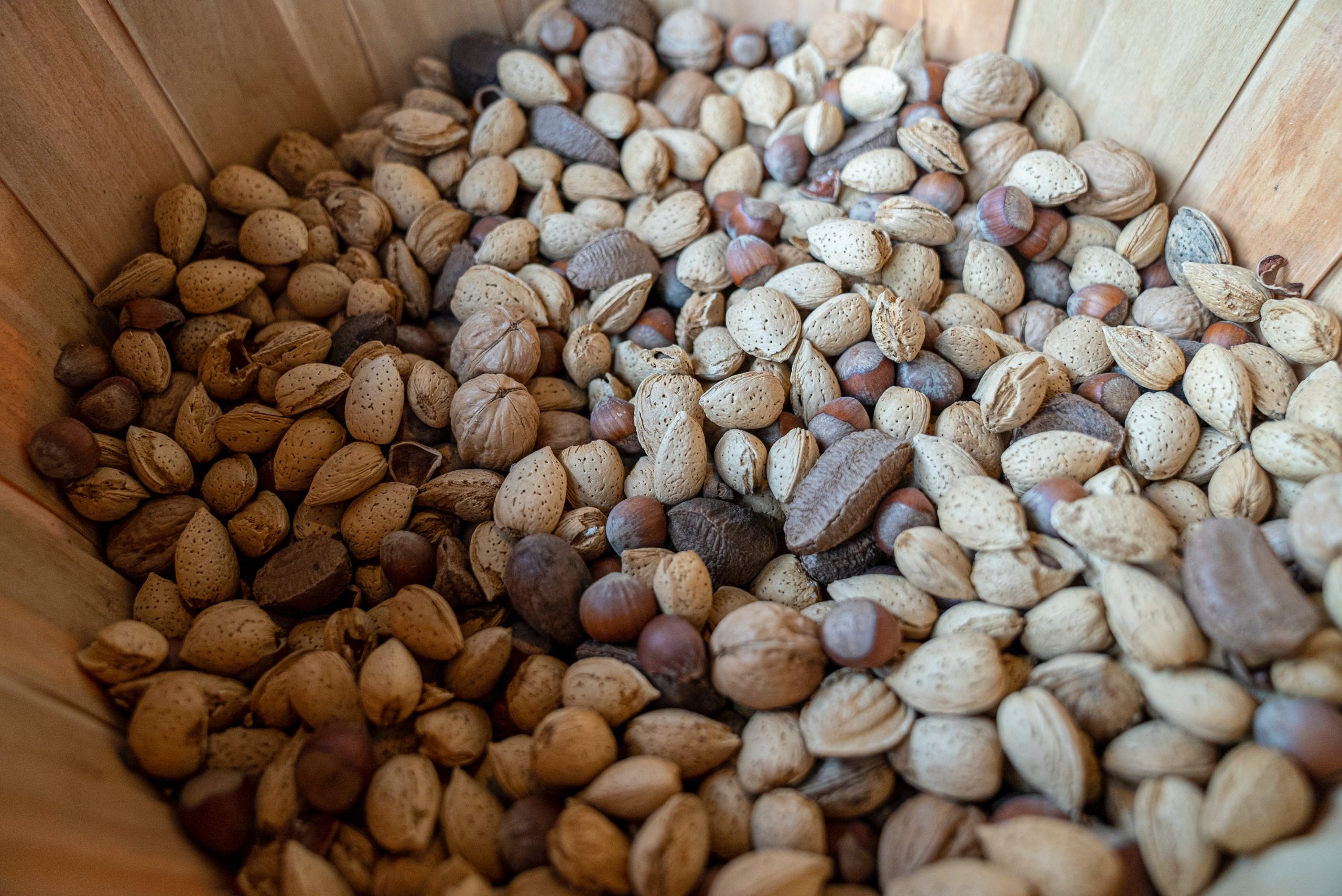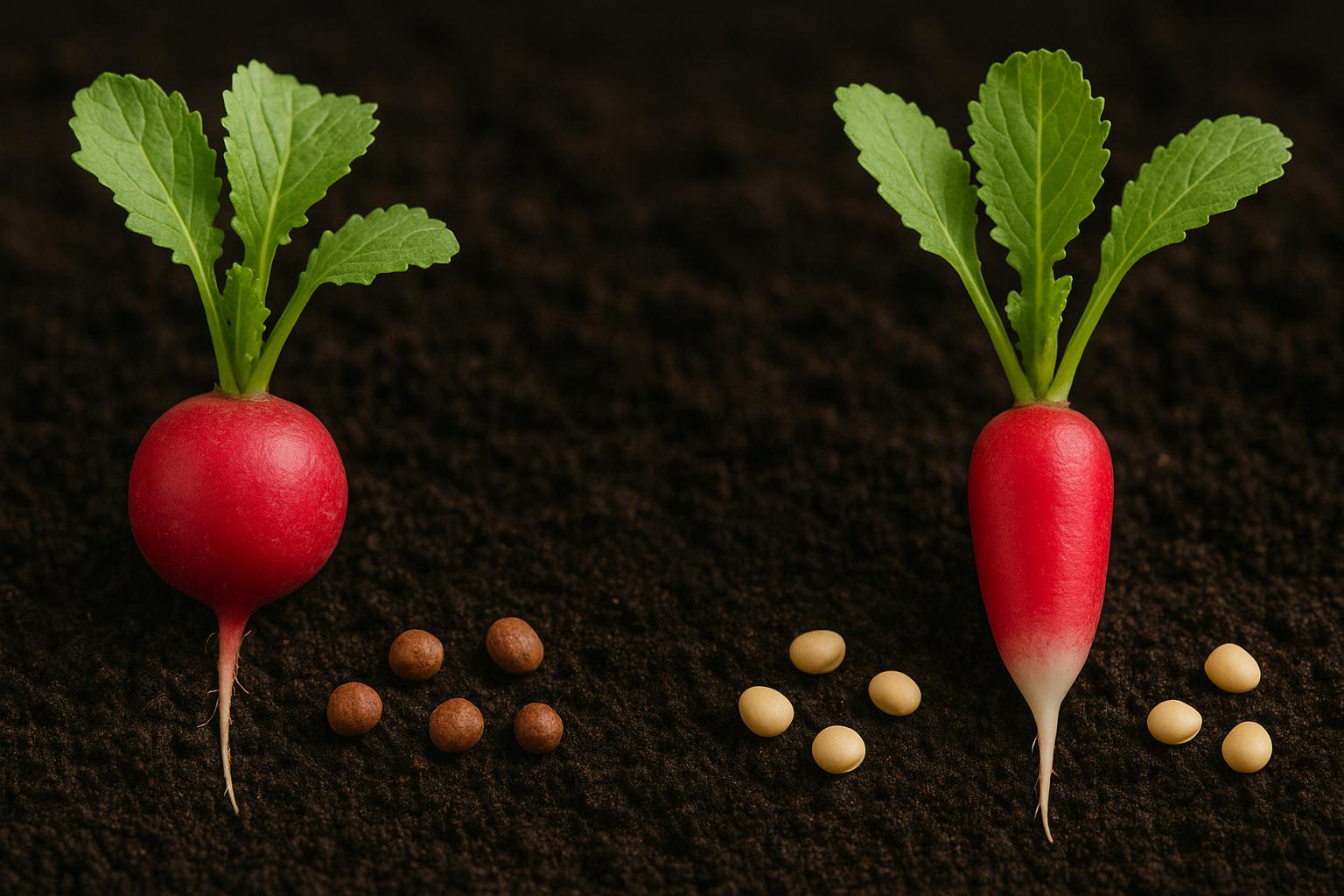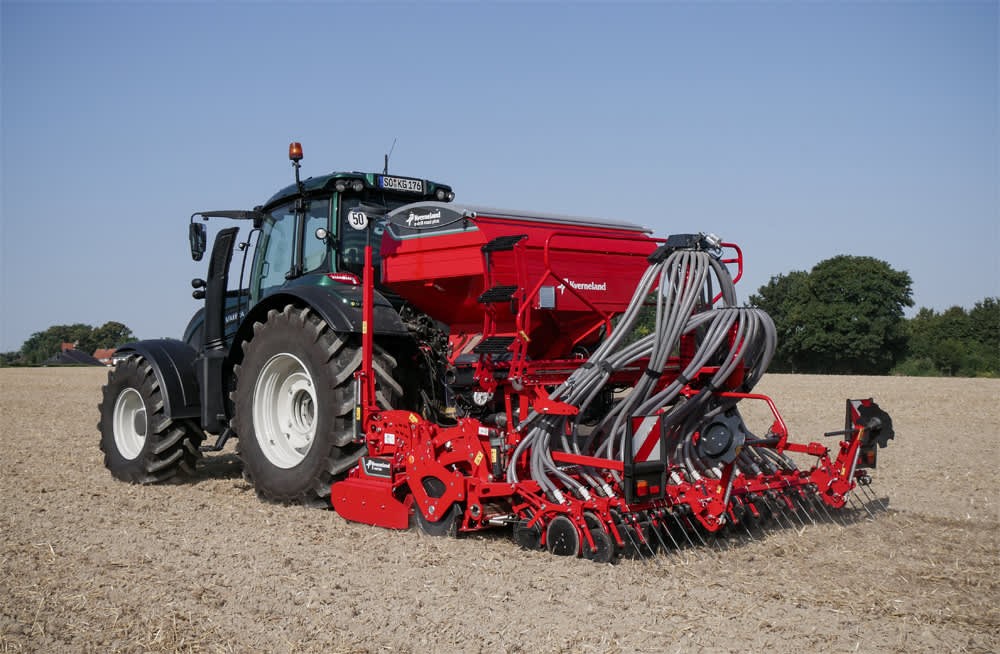Home Garden
Mastering Nut Preservation Elevate Your Culinary Journey

Home Garden
Hybrid vs. Traditional Radish Seeds: What’s the Difference?

Introduction
Radishes are among the fastest-growing root vegetables, and choosing the right type of seed, hybrid or traditional—can greatly impact your harvest. While both types belong to the same family (Raphanus sativus), their genetic makeup, growing behavior, and yield performance vary significantly. For home gardeners, small farmers, or commercial cultivators, understanding the real difference between hybrid and traditional radish seeds is essential.
Hybrid seeds are created through controlled pollination between two different parent plants to produce offspring with desired traits, while traditional seeds—often referred to as open-pollinated or heirloom—are naturally pollinated and passed down through generations. But how do these differences translate to the field? This article explains how each performs in terms of yield, taste, climate adaptability, seed-saving, and more.
What Makes Hybrid Radish Seeds Genetically Different?
F1 hybridization is the process of cross-pollinating two genetically stable parent lines to create hybrid radish seeds. The objective is to produce a new variety that combines the best qualities of both parents, such as pest resistance, uniform size, or quicker growth.
Instead of being transgenic, as GMOs are, this genetic change is the result of selective breeding. Consequently:
- The first generation (F1) shows increased vigor, also called heterosis.
- Plants tend to be more uniform and predictable.
- Yield often increases by 20–40% compared to open-pollinated varieties.
Traditional seeds, however, maintain genetic diversity. While this allows them to adapt to various soil types and weather, it also results in varied growth and harvest times.
Are Hybrid Radish Seeds Better in Yield and Growth Speed?
One of the major advantages of hybrid seeds is their performance consistency. In controlled trials, hybrid radish varieties have outperformed traditional types in key categories:
- Maturity period: 25–30 days (hybrid) vs. 35–45 days (traditional)
- Average root size: 100–150g (hybrid) vs. 70–90g (traditional)
- Marketable yield per hectare: up to 35% more with hybrids
Commercial farmers will be more profitable as a result of this quicker turnaround and greater market production. However, because of their robustness and rich flavour, conventional radish seeds are still often used in kitchen gardens.
When considering your next crop cycle, it’s practical to compare both types before making a decision. For those ready to plant, you can easily Buy Radish Seeds suitable for your regional climate and soil type from agricultural suppliers offering certified stock.
Flavor and Texture: Which Type Wins?
Traditional radish varieties are often prized for their earthy flavor, spice levels, and dense texture. This makes them popular for raw consumption, pickling, or regional recipes. For example:
- ‘Pusa Chetki’ (traditional) is known for its distinct pungency and crisp white flesh.
- Hybrid varieties like ‘Kashi Hans’ focus on mildness, ideal for commercial markets.
Aesthetics and Uniformity in Harvest
Uniformity is where hybrid seeds excel. These seeds are bred to produce radishes with similar size, shape, and maturity dates. This makes sorting, packaging, and selling easier for commercial growers. In comparison:
- Hybrids typically yield 85–90% uniform roots.
- Traditional seeds offer around 60–70% uniformity, depending on growing conditions.
For small-scale farmers and market gardeners, uniform harvests reduce post-harvest labor and enhance visual appeal at retail points.
Can You Save Hybrid Seeds?
No, hybrid seeds aren’t the best for preserving seeds. The parent traits of hybrid radish plants are not retained in the seeds. They frequently produce second-generation (F2) offspring that are unpredictable. Genetic segregation is the direct cause of this.
In contrast, traditional seeds are open-pollinated and genetically stable. You can:
- Save seeds from healthy plants.
- Expect similar traits in the next generation.
- Reduce seed purchasing costs over time.
Seed sovereignty is one of the key reasons why traditional seeds are still favored among organic farmers and subsistence growers.
How Do They Perform in Different Climates?
Conventional radish seeds are typically more suited to local climate changes. These cultivars grow more resilient to regional pests, soil acidity, and precipitation trends over many generations. For instance, steep landraces are more tolerant of cold.
Conversely, hybrids are bred for certain circumstances. They perform worse under stress, even when they flourish in the best conditions. Trials have revealed that numerous novel hybrid kinds are now made to withstand heat and disease.
- Up to 50% lower pest incidence in hybrid varieties.
- Better performance in semi-arid climates with drip irrigation.
For detailed data on climatic adaptability of specific radish varieties, the Indian Council of Agricultural Research (ICAR) regularly publishes region-wise trial reports.
“Heirloom seeds tell the story of the land, while hybrids write a new chapter with each season.” – Seed Diversity Conservancy, India
Soil Preferences and Fertility Response
Both hybrid and traditional radish seeds grow well in loamy, well-drained soils, but hybrids respond better to controlled fertilization. With balanced application of nitrogen, phosphorus, and potassium, hybrid varieties can show:
- Faster germination (within 2–3 days)
- Rapid foliage growth for photosynthesis
- Bulkier root development
Traditional varieties, however, often handle nutrient fluctuations more gracefully and may require fewer interventions, especially in organically managed plots.
Pest and Disease Resistance Comparison
Modern hybrid radish varieties are increasingly being bred for resistance to common diseases like:
- Downy mildew
- Root-knot nematodes
- Alternaria leaf spot
Chemical sprays are not as necessary because of this inherent resilience. In comparative field tests, for instance, “Kashi Sweta” has demonstrated resistance to several fungal diseases.
On the other hand, traditional seeds have the potential to gradually develop natural immunity. By choosing disease-resistant plants, farmers that practice seed saving can gradually increase population resistance without the need for artificial inputs.
Cost Implications: Initial Investment and Long-Term Value
Hybrid seeds are more expensive per gram due to the cost of research, controlled pollination, and licensing. Yet, the return on investment is often higher because of:
- Faster crop turnover
- Higher yields
- Market preference for uniform produce
Although traditional seeds are less expensive up front and can be reused, the market value for large purchases may be diminished by the unpredictability of the product.
Traditional seeds may offer more long-term value in home gardens and self-sufficient farms, particularly in biodiverse or low-input systems.
Germination Rate: Which Type Is More Reliable?
Hybrid radish seeds tend to have higher lab-tested germination rates, usually between 85% and 95%. Traditional seeds hover between 75% and 85%, but field performance can be comparable with good seed care.
For optimal results with either type:
- Store seeds in cool, dry conditions.
- Avoid using seeds older than 1–2 years.
- Use raised beds for better moisture management.
For tools that help estimate seed viability and expected yield, the Seed Calculator by Washington State University is a practical resource.
Choosing Based on Market Needs vs. Home Use
Hybrids have advantages that directly convert into revenue if you’re growing radishes for commercial sale, particularly in markets with intense competition. Over time, their homogeneity, quicker maturity, and resilience to illness lower costs. However, traditional seeds provide unparalleled advantages for long-term sustainability, flavour preservation, and personal use.
Traditional radish varieties also promote local biodiversity and genetic resilience in community seed exchanges and organic cooperatives.
The Cultural Role of Traditional Radish Seeds
Traditional radish seeds have cultural significance beyond agriculture. Seasonal cuisines, customs, and farming traditions are closely linked to varieties like as “Mooli” in South Asia and “Daikon” in Japan. Saving seeds becomes not only a utilitarian task but a cultural habit handed across generations.
Despite their efficiency, hybrid seeds frequently substitute commercial standardisation for these cultural quirks. For this reason, the cultivation of traditional cultivars is actively promoted by numerous seed banks and conservation organisations.
Final Thoughts for Growers Looking Ahead
Choosing between hybrid and traditional radish seeds is more about which is better suited to your needs than about which is superior. Market farming benefits greatly from the speed and consistency that hybrids provide. Conventional seeds provide resilience, diversity, and a closer link with regional ecosystems.
Making the best decision depends on your soil, climate, market objectives, and agricultural philosophy. Knowing the distinctions between the cultivars will help you make better cultivation choices every year, whether you rotate them or set up different plots for each.
FAQs
Q1. Can I mix hybrid and traditional radish seeds in one plot?
Technically yes, but maturity rates and harvest windows will vary, which can complicate maintenance and harvest timing.
Q2. Which type is better for organic farming?
Traditional seeds are preferred for organic systems due to their adaptability and seed-saving ability.
Q3. Are hybrid radishes safe to eat?
Yes, hybrids are developed through natural breeding methods, not genetic engineering, and are completely safe.
Q4. Do hybrid radish seeds need more fertilizer?
They respond better to balanced fertilization, but do not necessarily need excessive amounts.
Q5. Can I plant saved seeds from hybrid radishes?
You can, but the results will likely be inconsistent in size, shape, and quality.
Checkout more on contrank.com
Business
Cushion Covers: Latest Trends, Insights, and Styling Tips in 2025

Introduction
Think about it—when was the last time you noticed how much of a difference a small detail made in your living room? Sometimes it’s the way sunlight falls on a corner, sometimes it’s the vase of flowers on the centre table. And very often, it’s thecushion covers.
They don’t just protect cushions. They set moods, bring warmth, and make spaces feel lived in. In 2025, cushion covers in India are playing a bigger role than ever—blending tradition with innovation, luxury with sustainability. This blog takes you through market insights, design directions, and styling ideas to help you reimagine your home with GM Fabrics’ signature touch.
The Role of Cushion Covers in Indian Homes
For many of us, cushion covers hold memories—Diwali evenings on the sofa, family chats after dinner, or lazy Sunday afternoons. They’re small, but they tie the room together.
In compact flats, simple beige or white cushion covers add airiness. In larger homes, layering bold patterns with textured fabrics creates richness. And in hotels or resorts, they are finishing touches that define a guest’s first impression of comfort. GM Fabrics has long understood this balance between practicality and artistry, designing covers that make everyday living feel refined.
India’s Cushion Covers Market in 2025
The cushion and pillow segment in India is no small player. It was pegged at ₹782.5 crore in 2024 and is set to touch ₹1,351 crore by 2033, growing at 5.8% CAGR. The push comes from a rising middle class, e-commerce convenience, and hospitality’s appetite for fine décor.
What’s trending in searches this year? Terms like “white sofa cushion cover” and “beige cushion covers” are showing up repeatedly—pointing to a love for subtle, minimal aesthetics. On the flip side, boutique hotels and high-end homes are choosing richer textures and artisan finishes. It’s a tale of two markets, both thriving.
Top Cushion Cover Trends in India (2025)
1. Sustainable and Eco-Friendly Choices
Sustainability isn’t a buzzword anymore—it’s a way of life. Cushion covers made from organic cotton, bamboo, linen, and even recycled polyester are in demand. They’re breathable, durable, and kind to the skin. Kilim-style cushion covers, handwoven by artisans, are gaining particular favour among eco-conscious buyers. Interestingly, nearly 70% of Indians say they’re willing to pay more for sustainable décor.
2. Luxe Textures & Fabrics That Speak Luxury
Velvet, bouclé, sherpa, and microsuede are the fabrics to watch. Jewel tones like emerald, cobalt, and mustard dominate, making spaces feel plush. And the details—mirror embroidery, tufting, tassels—turn even a plain cushion cover into a luxury accent.
3. Colours and Patterns with Personality
This year is all about balance. Earthy neutrals like sage and terracotta calm the eye, while bold jewel tones like sapphire or emerald add drama. Indian motifs—from Madhubani to block prints—are being digitally reinterpreted for durability and vibrancy. Young buyers, meanwhile, are gravitating towards abstract watercolours and geometric designs.
4. Personalisation and Custom Work
Cushion covers are becoming deeply personal. From monogrammed initials to custom embroidery, people are choosing covers that reflect identity. For hotels, custom branding has turned cushion covers into subtle but powerful branding tools.
Cushion Covers in Real-World Spaces
1. Urban Homes
Small apartments favour neutrals and easy-to-clean fabrics. Yet, layering works wonders—think oversized velvet squares paired with smaller block-printed lumbars.
2. Hospitality & Luxury Living
For hotels, cushion covers aren’t just décor—they’re a mark of luxury. Antimicrobial finishes, embroidery, and branded textures elevate rooms instantly.
3. Artisan & Sustainable Choices
Millennials and Gen Z are gravitating toward handwoven cushion covers. They’re stylish, yes, but they also carry a sense of responsibility and cultural pride.
4. E-Commerce & Global Exports
Online, microsuede and solid-colour cushion covers top sales. Globally, Indian cushion covers continue to travel far—nearly 3,000 shipments last year alone, with the US and Japan leading the list.
What Buyers Want in 2025
Today’s buyers are clear about what they want from their cushion covers:
- Eco-consciousness: They want products made responsibly, with natural or recycled fabrics.
- Comfort: The tactile feel matters. Soft, plush, and cozy covers win hearts.
- Flexibility: Mix-and-match options let people update styles without overhauling entire rooms.
Styling Cushion Covers: Expert Tips
1. Layer Textures and Sizes
Combine velvet with cotton, or bouclé with embroidery, to create depth. Try oversized floor cushions with slimmer lumbar covers for a designer look.
2. Play with Colour Stories
Start with earthy neutrals, then add a strong accent—say mustard or jade green. Keep one piece as a statement motif, like a Madhubani print, against solids.
3. Switch with the Seasons
Summer calls for light cottons in pastels, while winter feels right with velvet or sherpa cushion covers. Small swaps keep interiors fresh.
4. Choose Sustainable Options
Handwoven, organic, or upcycled cushion covers don’t just look good—they tell a story and support artisans.
Conclusion
The world of cushion covers in India is evolving quickly. What was once purely functional has now become a canvas for style, comfort, and personal storytelling. In 2025, trends are leaning towards sustainable materials, lush textures, versatile colour palettes, and personalised touches.
For GM Fabrics, cushion covers aren’t just accessories—they’re part of a lifestyle. They carry memories, create moods, and elevate spaces with elegance. Explore more atGM Fabrics and discover designs that turn everyday living into something extraordinary.
Home Garden
How Seed Drills Improve Efficiency and Yield

Introduction
Agriculture has come a long way from the traditional methods of planting crops by hand. As the global demand for food rises, farmers are turning to more efficient, precise, and technologically advanced equipment to meet the challenges of modern farming. One such innovation is the seed drill, a game-changer in the world of farming. But what exactly is a seed drill, and how does it improve efficiency and crop yield?
In simple terms, a seed drill is a machine used to plant seeds at a uniform depth and spacing, ensuring optimal growth conditions for each plant. While the idea of planting crops may seem basic, the method of doing so plays a significant role in the success of the harvest. In this article, we will explore how seed drills improve planting efficiency and contribute to higher crop yields. We will also take a closer look at the different types of seed drills, their benefits, and how they are transforming modern agriculture.
What Is a Seed Drill?
A seed drill is a farming tool designed to plant seeds at a consistent depth, with equal spacing between each seed, while also covering them with soil. Unlike traditional hand planting, where seeds are scattered by hand or thrown unevenly, seed drills ensure that seeds are placed exactly where they need to be for optimal growth. This precision is critical for maximizing crop yield.
Seed drills were invented in the 18th century by Jethro Tull, an English agricultural pioneer. Tull’s invention revolutionized agriculture by providing a faster, more efficient way to plant seeds. Today, seed drills have become an essential piece of equipment for modern farmers, available in various types and sizes to suit different crops and farming conditions.
How Seed Drills Improve Efficiency

Image by: Yandex.com
Seed drills contribute to farming efficiency in several important ways. These benefits go beyond simply saving time; they help to maximize the use of resources, improve plant growth, and ultimately lead to a more successful harvest.
1. Uniform Seed Placement
One of the key advantages of using a seed drill is its ability to place seeds at a uniform depth and spacing. When seeds are planted at consistent intervals, each plant has equal access to essential resources like water, nutrients, and sunlight. This uniformity helps plants grow at the same rate, resulting in a more even crop stand.
In traditional methods, where seeds are scattered by hand or planted manually, it’s difficult to maintain consistent spacing. This can lead to overcrowded areas, where plants compete for nutrients, and empty spaces where no crops grow. With a seed drill, this problem is eliminated, allowing for optimal growth conditions for each plant.
2. Increased Planting Speed
Traditional methods of sowing crops can be labor-intensive and time-consuming. In comparison, seed drills allow farmers to plant large areas of land much faster. This is especially beneficial during peak planting seasons when time is critical.
For example, a farmer using a manual method to plant seeds might take hours to cover just a few acres. A seed drill, on the other hand, can plant several acres in the same amount of time, increasing efficiency significantly. This time-saving advantage also helps farmers reduce labor costs and focus on other important tasks on the farm.
3. Reduced Seed Wastage
Seed wastage is a common problem with traditional planting methods. When seeds are scattered by hand, there’s always the possibility of using too many seeds in one area or too few in another. This inefficiency leads to wasted seeds, higher costs, and uneven crop growth.
Seed drills help reduce seed wastage by placing the right amount of seeds in each row, with no overlapping or underplanting. This precision ensures that farmers use only the necessary amount of seeds, helping to lower costs while maximizing planting success.
4. Improved Soil Coverage
After the seeds are placed in the soil by the seed drill, the machine also covers the seeds with a thin layer of soil. This helps protect the seeds from the elements, such as wind or rain, which could otherwise wash them away or cause them to dry out. The added soil coverage helps maintain moisture levels, creating a better environment for the seeds to germinate and grow.
In addition, this soil coverage helps with weed control. By covering the seeds properly, the drill ensures that the soil is compacted enough to reduce the growth of weeds, which can compete with crops for water and nutrients.
5. Better Soil Aeration
Many modern seed drills are equipped with features that improve soil aeration. By placing the seeds at a consistent depth and allowing air to circulate around them, seed drills help maintain the right balance of soil oxygen levels. This improves seed germination and root growth, leading to healthier plants.
With good soil aeration, crops are better able to establish strong root systems, which in turn leads to stronger, more resilient plants that can withstand environmental stressors such as drought or high winds.
How Seed Drills Improve Yield
Beyond improving efficiency, the use of seed drills plays a crucial role in boosting crop yield. With precision planting, optimized resource use, and healthier plants, seed drills contribute to higher productivity on the farm. Here are some ways seed drills directly impact yield:
1. Enhanced Germination Rates
When seeds are placed at the right depth and spacing, they have a better chance of germinating successfully. Seed drills create an ideal environment for seeds to sprout by ensuring they’re neither too deep (which can hinder germination) nor too shallow (which can expose them to harsh conditions). This precision leads to higher germination rates, which ultimately results in a stronger, more productive crop.
2. Optimized Resource Use
Seed drills help ensure that crops have equal access to essential resources, such as water and nutrients. When plants are spaced properly, they have enough room to grow without competing for these vital resources. This leads to healthier plants and, ultimately, a better yield. Proper spacing also allows for easier application of fertilizers and pesticides, ensuring that resources are used efficiently.
3. Increased Crop Density
Seed drills allow farmers to plant crops at the ideal density for maximum yield. By optimizing the number of seeds per square meter, farmers can achieve higher crop density without overcrowding, leading to better overall production. Higher crop density often translates to better use of land, especially in areas where space is limited or valuable.
4. Reduced Soil Erosion
By improving soil coverage and reducing seed wastage, seed drills help reduce soil erosion. Soil erosion can strip away the topsoil, which is the most fertile part of the soil. With better seed placement and soil protection, seed drills help maintain the integrity of the soil, ensuring that the land remains productive year after year.
Types of Seed Drills
There are different types of seed drills available, each designed to suit specific farming needs. The most common types include:
- Traditional Seed Drills: These drills are designed to plant a variety of crops, including grains, legumes, and oilseeds. They’re equipped with a metering system that ensures seeds are placed evenly.
- No-Till Seed Drills: These drills allow farmers to plant seeds directly into undisturbed soil, reducing the need for plowing. This method helps conserve soil moisture, reduce erosion, and preserve soil structure.
- Air Seeders: Air seeders use air pressure to move seeds into the soil. They are ideal for planting in large fields and can cover a wide area quickly.
- Compact Seed Drills: These are smaller drills designed for smaller farms or gardens. They are easy to operate and are great for precision planting in tight spaces.
Conclusion
Seed drills have revolutionized the way we approach farming, offering unparalleled efficiency and the potential for higher crop yields. By ensuring uniform seed placement, reducing wastage, and optimizing resource use, these machines are transforming modern agriculture. Whether you’re a small-scale farmer or operating a large commercial farm, incorporating a seed drill into your farming practices can save you time, reduce costs, and improve productivity.
The benefits of using a seed drill are clear: better seed germination, improved soil health, and increased crop yield. As farming continues to evolve, technologies like seed drills are essential for meeting the growing demand for food while minimizing environmental impact. Embracing this tool will not only improve efficiency but also contribute to a more sustainable future for agriculture.
-
Business2 years ago
Cybersecurity Consulting Company SequelNet Provides Critical IT Support Services to Medical Billing Firm, Medical Optimum
-
Business2 years ago
Team Communication Software Transforms Operations at Finance Innovate
-
Business2 years ago
Project Management Tool Transforms Long Island Business
-
Business2 years ago
How Alleviate Poverty Utilized IPPBX’s All-in-One Solution to Transform Lives in New York City
-
health2 years ago
Breast Cancer: The Imperative Role of Mammograms in Screening and Early Detection
-
Sports2 years ago
Unstoppable Collaboration: D.C.’s Citi Open and Silicon Valley Classic Unite to Propel Women’s Tennis to New Heights
-
Art /Entertainment2 years ago
Embracing Renewal: Sizdabedar Celebrations Unite Iranians in New York’s Eisenhower Park
-
Finance2 years ago
The Benefits of Starting a Side Hustle for Financial Freedom
































